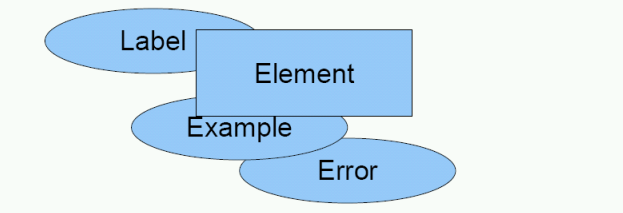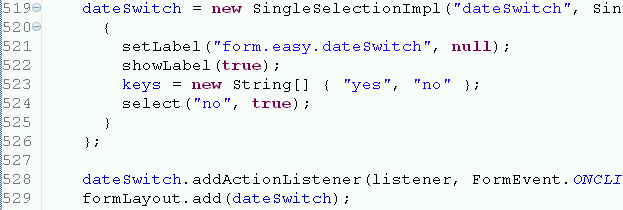-
- 所有超级接口:
- FormBaseComponentIdProvider
- 所有已知子接口:
- Cancel, DateChooser, FileElement, FormItemContainer, FormLink, FormMultipartItem, FormToggle, InlineElement, InlineIntegerElement, InlineTextElement, IntegerElement, MultipleSelectionElement, Reset, RichTextElement, SelectionElement, SingleSelection, SpacerElement, StaticTextElement, Submit, TextBoxListElement, TextElement
- 所有已知实现类:
- AbstractTextElement, DateElement, FileElementImpl, FlexiTableElementImpl, FormCancel, FormItemImpl, FormLayoutContainer, FormLinkImpl, FormReset, FormSubmit, FormToggleImpl, IntegerElementImpl, JSDateChooser, MultipleSelectionElementImpl, MultiSelectionTree, RichTextElementImpl, SingleSelectionImpl, SpacerElementImpl, StaticTextElementImpl, TextAreaElementImpl, TextBoxListElementImpl, TextElementImpl
public interface FormItem extends FormBaseComponentIdProvider
Summary:
setting panels content is optional and params can always be null- setXyzKey(String i18nKey, String[] params)
- setErrorComponent(FormItem quickFixWizard)
- $r.render("formElementName_LABEL")
- $r.render("formElementName_ERROR")
- $r.render("formElementName_EXAMPLE")
- $f.isMandatory("formElementName")
- $f.hasError("formElementName")
- $f.hasExample("formElementName")
- $f.hasLabel("formElementName")
FormDecoratorinstance in the velocity.Description:
Each implemented form item consists of 4 panels appearing as div's in the html rendered page. They belong together in a logical way, but are layoutable, e.g. placeable anywhere within a velocity page. The following figure illustrates the logical composition.

- the Element panel
The form element panel holds for example one or more checkboxes, a dropdownbox, an input field, ... any other html form element, a link!, a custom element! - the Label panel
textlabel for the element - the Error panel
Either a textlabel as error text or another form element. This form element can then start a subworkflow explaining the error or for fixing the error. - the Example panel
example text, explaing an input format or how to proceed with the shown element.

The java code to create the above yes-no-switch looks as follows. Please note the anonymous class creation style, with a initializer block. This helps grouping the code:

- 519: dateSwitch is the name of the element in the velocity container
- 521/522: form.easy.dateSwitch is the i18n key for labeling, and the label is made visible.
- 523/524: sets the i18n keys for yes and no, and selects no as default
- 528: add an onclick listener, so you get informed if yes or no is clicked
- 529: final step of adding the form element to form (layout), it is then available in the velocity page layouting the form under the name dateSwitch
The form item goes to a velocity page under defined name, e.g. dateSwitch, and the corresponding logical panels are accessed with the following convention:
- form element name_LABEL
- form element name_ERROR
- form element name_EXAMPLE

It is very common that a layout needs information about whether a form item has an error, example, label or is mandatory. This information is available through aorg.olat.presentation.framework.components.form.flexible.FormDecoratorwhich can be accessed for example as $f.hasError("dateSwitch").The
FormItemis aggregated withinFormItemContainerand both together form the composite pattern.
They play together with theComponentandContainerInitial Date: 24.11.2006
- 作者:
- patrickb
-
-
字段概要
字段 限定符和类型 字段和说明 static java.lang.StringERRORCstatic java.lang.StringEXAMPLECstatic java.lang.StringLABELC-
从接口继承的字段 org.olat.presentation.framework.core.components.form.flexible.FormBaseComponentIdProvider
DISPPREFIX
-
-
方法概要
方法 限定符和类型 方法和说明 voidaddActionListener(Controller listener, int events)voidclearError()error is resolved, e.g. hasError() should return false and the error component gets invisible (and resetted)voiddoDispatchFormRequest(UserRequest ureq)called if this component is dispatched, e.g. was clicked (double clicked, ...)voidevalFormRequest(UserRequest ureq)called if just the form values must be remembered for the next render process.intgetAction()java.util.List<java.lang.String>getActionListenersFor(int event)ComponentgetComponent()The elements panel to be rendered by the GUI Framework.ComponentgetErrorC()a complex "error" message, or a helper wizard to fix the error may be This method is used by a form infrastructure provider.java.lang.StringgetErrorText()This method is used by a form infrastructure provider.ComponentgetExampleC()translated example text, wrapped in component This method is used by a form infrastructure provider.java.lang.StringgetExampleText()This method is used by a form infrastructure provider.ComponentgetLabelC()label panel of the form item,nullif no label provided/rendered This method is used by a form infrastructure provider.java.lang.StringgetLabelText()label panel of the form item,nullif no label provided/rendered This method is used by a form infrastructure provider.java.lang.StringgetName()The form item's name within an manageing form container.FormgetRootForm()a form item always has a root container where it belongs to.TranslatorgetTranslator()java.lang.ObjectgetUserObject()booleanhasError()booleanhasExample()booleanhasFocus()true if this element tries to get focus.booleanhasLabel()booleanisEnabled()true if item is marked as editable.booleanisMandatory()true if the form item should contain a (valid) value.booleanisVisible()true if form item was marked visible.voidreset()reset the data in the field to a initial/predefined value.voidsetEnabled(boolean isEnabled)item is enabled/disabled, e.g. editable/read only in contrast to setVisible this does NOT DISABLE label, example, error!voidsetErrorComponent(FormItem errorFormItem, FormLayouter container)a complex "error" message, or a helper wizard to fix the error.voidsetErrorKey(java.lang.String errorKey, java.lang.String... params)Sets the i18n key for this form item's error message and displays the error message if showErro(true) is set.voidsetExampleKey(java.lang.String exampleKey, java.lang.String[] params)key for example with params to fillvoidsetFocus(boolean hasFocus)true if the element should (try to) get focus, false is defaultvoidsetLabel(java.lang.String labelkey, java.lang.String[] params)Key to be translated with the form translator and placed in the label panel.FormItemsetLabelComponent(FormItem labelComponent, FormItemContainer formLayout)see setErrorComponent for commentsvoidsetMandatory(boolean isMandatory)Shows a mandatory icon next to this form item.voidsetRootForm(Form rootForm)voidsetTranslator(Translator translator)voidsetUserObject(java.lang.Object userObject)voidsetVisible(boolean isVisible)item, label, example, error get not visiblevoidshowError(boolean show)voidshowExample(boolean show)voidshowLabel(boolean show)voidvalidate(java.util.List<ValidationStatus> validationResults)validate the data in the field, create error messages or update any component.-
从接口继承的方法 org.olat.presentation.framework.core.components.form.flexible.FormBaseComponentIdProvider
getFormDispatchId
-
-
-
-
字段详细资料
-
ERRORC
static final java.lang.String ERRORC
- 另请参阅:
- 常量字段值
-
EXAMPLEC
static final java.lang.String EXAMPLEC
- 另请参阅:
- 常量字段值
-
LABELC
static final java.lang.String LABELC
- 另请参阅:
- 常量字段值
-
-
方法详细资料
-
evalFormRequest
void evalFormRequest(UserRequest ureq)
called if just the form values must be remembered for the next render process. Do not validate data and create error messages.This method must be implemented by a specialised form item provider.
- 参数:
ureq-dispatchIDs-nextPos-
-
validate
void validate(java.util.List<ValidationStatus> validationResults)
validate the data in the field, create error messages or update any component.This method must be implemented by a specialised form item provider.
-
reset
void reset()
reset the data in the field to a initial/predefined value. This method is called if in a form a reset request is issued. It is the counterpart to the validate call which
-
setFocus
void setFocus(boolean hasFocus)
true if the element should (try to) get focus, false is default- 参数:
hasFocus-
-
hasFocus
boolean hasFocus()
true if this element tries to get focus.- 返回:
-
doDispatchFormRequest
void doDispatchFormRequest(UserRequest ureq)
called if this component is dispatched, e.g. was clicked (double clicked, ...)Please note, that the caller is not the GUI Framework but the form items manageing class. A default and exemplary implemention is
Form.This method must be implemented by a specialised form item provider.
- 参数:
ureq-dispatchIDs-nextPos-
-
getName
java.lang.String getName()
The form item's name within an manageing form container. This has nothing to do with a name displayed on the screen to the user.
The default implementationFormItemImpluses the name to make the element available in the velocity container.This method is used by a form infrastructure provider.
- 返回:
-
getComponent
Component getComponent()
The elements panel to be rendered by the GUI Framework.- 返回:
-
getRootForm
Form getRootForm()
a form item always has a root container where it belongs to. The root container is responsible for the opening and closing HTML FORM tag.This method must be implemented by a specialised form item provider.
- 返回:
-
getLabelC
Component getLabelC()
label panel of the form item,nullif no label provided/renderedThis method is used by a form infrastructure provider.
- 返回:
-
getLabelText
java.lang.String getLabelText()
label panel of the form item,nullif no label provided/renderedThis method is used by a form infrastructure provider.
- 返回:
-
setLabel
void setLabel(java.lang.String labelkey, java.lang.String[] params)Key to be translated with the form translator and placed in the label panel.- 参数:
labelkey- i18n keyparams- i18n key parameters
-
setLabelComponent
FormItem setLabelComponent(FormItem labelComponent, FormItemContainer formLayout)
see setErrorComponent for comments- 参数:
labelComponent-layout-
-
isMandatory
boolean isMandatory()
true if the form item should contain a (valid) value.- 返回:
-
setMandatory
void setMandatory(boolean isMandatory)
Shows a mandatory icon next to this form item. This is only a GUI cue, it does not activate any validators. It is in the developer's responsibility to validate the form.- 参数:
isMandatory- Whether this form item should have a mandatory icon.
-
setErrorKey
void setErrorKey(java.lang.String errorKey, java.lang.String... params)Sets the i18n key for this form item's error message and displays the error message if showErro(true) is set.- 参数:
errorKey- i18n key for the error message.params- Additional error message contents.
-
setErrorComponent
void setErrorComponent(FormItem errorFormItem, FormLayouter container)
a complex "error" message, or a helper wizard to fix the error.
It must be a form item itself, that starting the fixing workflow let the surrounding form evaluate (intermediate save values).
Typically aFormLinkis used here to start a workflow in a modal dialog.
Use showError(true) for the visibility of the error.- 参数:
errorFormItem-container- the container containing the form item which has the error
-
getErrorC
Component getErrorC()
a complex "error" message, or a helper wizard to fix the error may beThis method is used by a form infrastructure provider.
null
-
getErrorText
java.lang.String getErrorText()
This method is used by a form infrastructure provider.
- 返回:
-
getExampleC
Component getExampleC()
translated example text, wrapped in componentThis method is used by a form infrastructure provider.
- 返回:
-
getExampleText
java.lang.String getExampleText()
This method is used by a form infrastructure provider.
- 返回:
-
setExampleKey
void setExampleKey(java.lang.String exampleKey, java.lang.String[] params)key for example with params to fill- 参数:
exampleKey- , null to clear exampleparams- , may be null
-
setTranslator
void setTranslator(Translator translator)
- 参数:
translator-
-
getTranslator
Translator getTranslator()
- 返回:
-
setVisible
void setVisible(boolean isVisible)
item, label, example, error get not visible- 参数:
isVisible-
-
isVisible
boolean isVisible()
true if form item was marked visible.
-
setEnabled
void setEnabled(boolean isEnabled)
item is enabled/disabled, e.g. editable/read only in contrast to setVisible this does NOT DISABLE label, example, error!- 参数:
isEnabled-
-
isEnabled
boolean isEnabled()
true if item is marked as editable.- 返回:
-
hasError
boolean hasError()
- 返回:
-
hasLabel
boolean hasLabel()
- 返回:
-
hasExample
boolean hasExample()
- 返回:
-
setRootForm
void setRootForm(Form rootForm)
- 参数:
rootForm-
-
showLabel
void showLabel(boolean show)
- 参数:
show-
-
showError
void showError(boolean show)
- 参数:
show-
-
clearError
void clearError()
error is resolved, e.g. hasError() should return false and the error component gets invisible (and resetted)
-
showExample
void showExample(boolean show)
- 参数:
show-
-
addActionListener
void addActionListener(Controller listener, int events)
- 参数:
listener-events-
-
getActionListenersFor
java.util.List<java.lang.String> getActionListenersFor(int event)
- 参数:
event-- 返回:
-
getAction
int getAction()
- 返回:
-
setUserObject
void setUserObject(java.lang.Object userObject)
- 参数:
userObject-
-
getUserObject
java.lang.Object getUserObject()
- 返回:
-
-